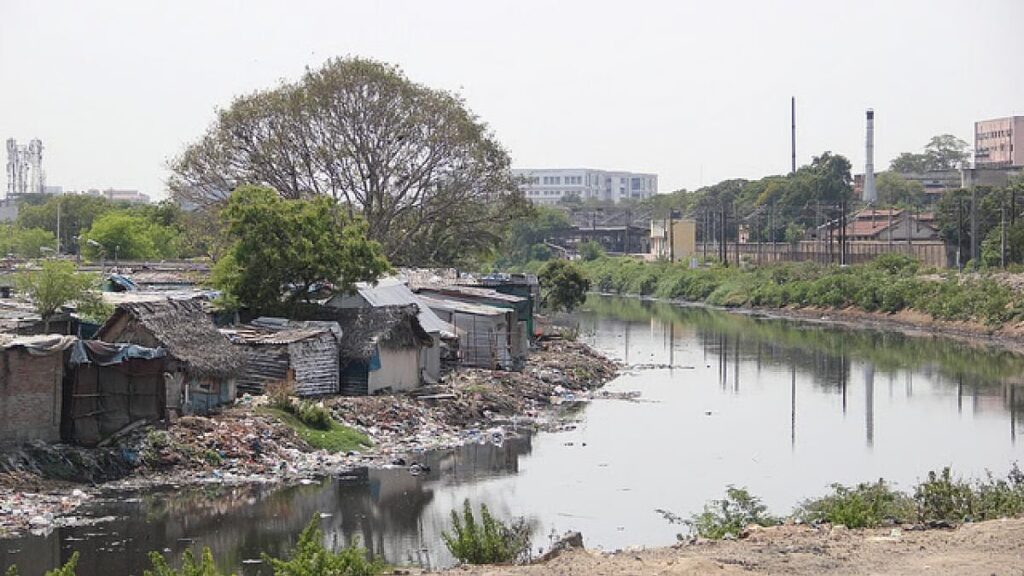Chennai, there’s one river that holds stories of glory, trade, and tragedy, all in a meandering 65-kilometre stretch. The Cooum. Once celebrated as the “Thames of South India”, now reduced to one of the most polluted rivers in the country. But beneath the stench and silt, it still whispers its past.
“A river is more than a ribbon of water; it’s a ribbon of history.”
A River That Almost Divides a city
The Cooum originates in a small village of the same name in Tiruvallur district. It ends its journey in the Bay of Bengal. It is almost slicing Chennai into two halves. Once, this was a freshwater lifeline. Slow, narrow, and winding, it touched countless lives along its course.
In fact, ancient temple records speak of attaining salvation by taking a dip in its waters. A single thought almost unthinkable today. The name itself may have come from the Tamil coopam, meaning “deep well” or “pit,” hinting at its once-abundant water. Another theory points to coovalan, a person skilled in the knowledge of wells and groundwater. Both fit.
From Rome to Mylapore
Long before highways and harbours took centre stage, Cooum was a trade highway of its own. In ancient times, it connected to the bustling port of Mylapore. Roman ships anchored nearby, trading gold, silver, copper, and fine wines for Indian textiles, gems, and spices.

Archaeologists have even found Roman wine jars and coins along its banks, along with Chinese currency, proof of its global footprint. This wasn’t just a waterbody; it was an artery of commerce and culture.
The Nine Bridges Over Chennai’s History
Today, the Cooum is spanned by nine major bridges. They are Napier, Wallajah, Periamet, Chintadripet (St. Andrew’s), Harris, Commander-in-Chief Road, College Road, Spur Tank, and Aminjikarai. Plus smaller ones maintained by the Corporation of Chennai. These aren’t just traffic solutions. Each one is a silent witness to decades of change, from horse-drawn carriages to drone shots for cinema.
Back in 1710, a cut was made to link the Cooum with the nearby Elambore River to control flooding. A bridge was built there too, an early sign that this city has always been negotiating with its rivers.
Decline of a Waterway in Chennai
The Cooum’s fall was not sudden; it was a slow unravelling. Excessive irrigation upstream, uncollected sewage, industrial effluents, and rampant encroachments choked the river. Littoral drift at its mouth blocked its natural flushing, leaving stagnant pools of dark, toxic water.
By the late 20th century, the once-navigable river had become a dumping ground. The transformation was heartbreaking. Where fishermen once pulled in prawns and crabs in abundance, now only debris and chemical foam floated.
A Glimmer of Restoration
Yet, hope refuses to vanish completely. In 2015, the Water Resources Department began the Integrated Cooum River Eco-Restoration Plan, aiming to clean stretches of the river and revive some of its lost dignity. It’s an uphill task, yes. But rivers have remarkable resilience when given a chance.
More Than Just Water
The Cooum is a paradox. It’s both a cultural artefact and an environmental crisis. It holds centuries of memory in its bends, from maritime glory to the colonial engineering of bridges, from temple legends to urban neglect.
And perhaps that’s why the line “Kundhikinnu Koovikinom?” “Which river are we calling to?” It carries such weight here. We’re not just calling to a waterbody. We’re calling to history, heritage, and the hope that one day, Chennai’s River will flow clean again.
If you stand on Napier Bridge and watch the Cooum meet the sea, it’s hard not to imagine what it looked like centuries ago alive, bustling, and free. Maybe, someday, we’ll stop just crossing it, and start celebrating it again.
For part 1, part 2 and Part 3
Check my Youtube channel
Subscribe to our email newsletter to get the latest posts delivered right to your email.

Comments